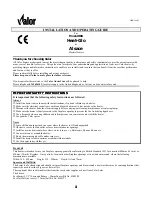
STORAGE/BURNER REMOVAL
WHEN STORING THE HEATER THE CONNECTION BETWEEN THE PROPANE TANK AND THE
HEATER MUST BE DISCONNECTED AND THE PROPANE TANK REMOVED FROM THE
ENCLOSURE AND STORED INDOORS IN A WELL VENTILATED AREA OR IN ACCORDANCE
WITH CHAPTER 5 OF THE STANDARD FOR THE STORAGE AND HANDLING OF LIQUEFIED
GASES, ANSI/NFPA 58-1998.
CLEANING:
Your heater will last longer if maintained properly. It is important that the flow of combustion air must
never be obstructed, orifice and air openings must be kept free of dirt and spider webs. Never use a
cleaning agent which is flammable or corrosive.
It is recommended that the heater body components; from the burner head down, are periodically
protected with a coat of automobile wax .
If repainting is necessary, paint only the post/base assembly. Never paint the reflector, emitter assembly
the safety control valve cylinder, valve panel or instruction plate on post.
The posts of the burner must remain clean so that the gas flow is unrestricted. The air inlet of the venturi
tube must also be kept clean for combustion air supply if the heater is not performing properly it may be
necessary to clean the burner (see burner removal).
BURNER REMOVAL:
1.
Remove reflector and emitter assembly by removal of the screws that fasten the
emitter assembly to the lower screen cone .
2.
Remove the burner by unscrew the burner from the top to the valve body.
Any debris in the opening of the burner assembly can be cleared with a straightened piece of coat hanger.
Any rust can be removed carefully with a wire brush. Never use a piece of wood or other materials that
might break off and block the ports.
Caution:
Bugs and small insects are easily get into the burner, gas orifice and burner checking is required
after a period of storage of heater.
Tips:
Light on the Patio Heater once a month will ensure your heater always in good condition.
Page 14
Summary of Contents for PTH-103-3G
Page 5: ......






































